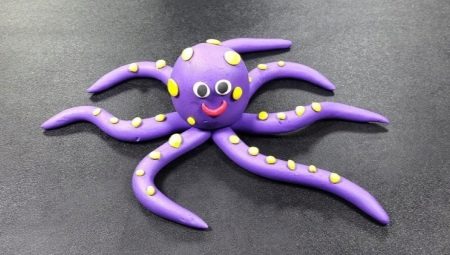Modeling octopuses from plasticine

Modeling octopuses from plasticine is an exciting experience. It is worth making sure of this in practice, having blinded a few bright octopuses with a child for his personal "oceanarium".



How to mold on cardboard?
This type of obtaining octopuses from plasticine is available even for older preschool children who are just preparing for school. But it is hardly reasonable to entrust the smaller ones with such an occupation. The process involves the use of bright and catchy details, decorative elements. To work, you need to stock up on colored cardboard. As a basis, you can take the image of a character from the cartoon "Octopuses" - it is much more attractive than real photographs.
The sculpting process looks like this step by step:
- gradually draw the figure of an octopus on a sheet;
- place the same number of "suckers" (points) in each of the tentacles;
- carefully outline the outline of the animal with a pink mass;
- make white eyes;
- prepare blue-black pupils;
- form a red mouth;
- arrange the suction cups with the most even strokes of blue and blue colors
- add small, laconic green circles next to the suction cups;
- to supplement the composition with balls of various tones - their color is chosen solely at their discretion;
- with the help of a stack, notch eyes so that they look more expressive;
- add a blue nose.



How to make a 3D shape?
But not everyone likes a flat composition on a sheet of paper or cardboard, and many just want to diversify their skills. It is quite possible to fashion an octopus in three dimensions in stages, and this can be done even without much experience.
Key steps:
- obtaining 8 white and blue limbs of the same length;
- a strong bunch of them together;
- docking in the form of a snowflake (this is the easiest way to make tentacles);
- sculpting a medium-sized blue head resembling a drop;
- adding a pair of eyes and setting the head in its proper place;
- wrapping tentacles in the form of rings;
- decorating crafts with bright details;
- optional - adding starfish and other underwater fauna.



Recommendations
The smallest children do not have to create lush multicolored compositions. Lessons on sculpting a two-color figure of an underwater inhabitant will be enough for them. The specific color combination is not important here - more important is the correspondence of form and appearance. A shimmery and iridescent figure can be obtained by coating the craft with nail polish containing glitter. The octopus head is easy to obtain by sharpening the ball on one side like a bullet. The yellow balls can be turned into suckers by pressing them with toothpicks.
The eyes can be made large, much larger than that of a real octopus. In general, in their appearance it is allowed to show maximum imagination. Plasticine cakes of different tones, pressed against each other with your fingers, will give a gorgeous effect.
The limbs must be bent so that it seems that a molded mollusk is making its way through the water column.



You can glue the head with the legs both with a match and without it. There is no need to wait for the plasticine to harden. To further emphasize the marine theme, it is worth putting the craft in a glass jar of water. It is permissible to take as a basis not only the character of the cartoon "Octopussy", but also other films and cartoons - depending on what is more to your taste. If you want to make the mollusk as close to reality as possible, you need to abandon the design of the mouth.
Bright colors in this case are also contraindicated - natural octopuses look pretty faded, but that is why they are no less recognizable.


For information on how to mold an octopus from plasticine, see the next video.








